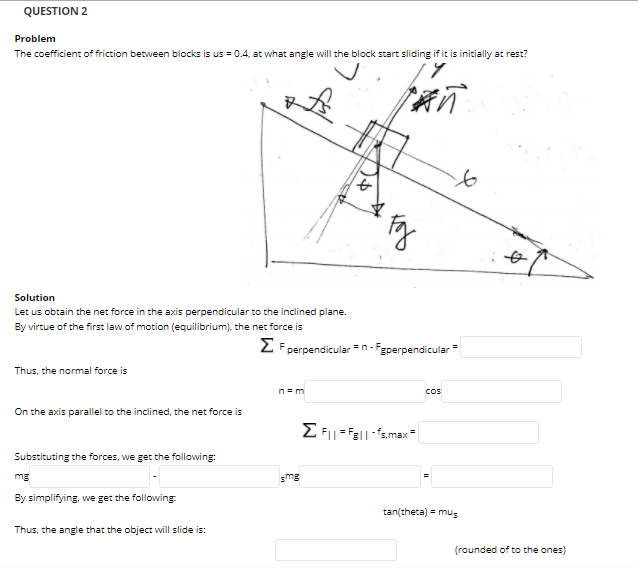QUESTION 2 Problem The coefficient of friction between blocks is us = 0.4, at what angle will the block start sliding if it is initially at rest? to Solution Let us obtain the net force in the axis perpendicular to the inclined plane. By virtue of the first law of motion (equilibrium), the ne: force is E Fperpendicular =n-Fgperpendicular= Thus, the normal force is n= m COs On the axis parallel to the inclined, the net force is Substituting the forces, we get the following: mg By simplifying, we get the following tan(theta) = mus Thus, the angle that the object will slide is: (rounded of to the ones)
QUESTION 2 Problem The coefficient of friction between blocks is us = 0.4, at what angle will the block start sliding if it is initially at rest? to Solution Let us obtain the net force in the axis perpendicular to the inclined plane. By virtue of the first law of motion (equilibrium), the ne: force is E Fperpendicular =n-Fgperpendicular= Thus, the normal force is n= m COs On the axis parallel to the inclined, the net force is Substituting the forces, we get the following: mg By simplifying, we get the following tan(theta) = mus Thus, the angle that the object will slide is: (rounded of to the ones)
University Physics Volume 1
18th Edition
ISBN:9781938168277
Author:William Moebs, Samuel J. Ling, Jeff Sanny
Publisher:William Moebs, Samuel J. Ling, Jeff Sanny
Chapter6: Applications Of Newton's Laws
Section: Chapter Questions
Problem 58P: Calculate the maximum acceleration of a car that is heading up a 4.00slope (one that makes an angle...
Related questions
Concept explainers
Rotational Equilibrium And Rotational Dynamics
In physics, the state of balance between the forces and the dynamics of motion is called the equilibrium state. The balance between various forces acting on a system in a rotational motion is called rotational equilibrium or rotational dynamics.
Equilibrium of Forces
The tension created on one body during push or pull is known as force.
Question
100%

Transcribed Image Text:QUESTION 2
Problem
The coefficient of friction between blocks is us = 0.4, at what angle will the block start sliding if it is initially at rest?
to
Solution
Let us obtain the net force in the axis perpendicular to the inclined plane.
By virtue of the first law of motion (equilibrium), the ner force is
2 F perpendicular =n- Fgperpendicular=
Thus, the normal force is
n= m
Cos
On the axis parallel to the inclined, the net force is
Substituting the forces, we get the following:
mg
smg
By simplifying, we get the following
tan(theta) = mus
Thus, the angle that the object will slide is:
(rounded of to the ones)
Expert Solution
This question has been solved!
Explore an expertly crafted, step-by-step solution for a thorough understanding of key concepts.
Step by step
Solved in 3 steps with 3 images

Knowledge Booster
Learn more about
Need a deep-dive on the concept behind this application? Look no further. Learn more about this topic, physics and related others by exploring similar questions and additional content below.Recommended textbooks for you

University Physics Volume 1
Physics
ISBN:
9781938168277
Author:
William Moebs, Samuel J. Ling, Jeff Sanny
Publisher:
OpenStax - Rice University

University Physics Volume 1
Physics
ISBN:
9781938168277
Author:
William Moebs, Samuel J. Ling, Jeff Sanny
Publisher:
OpenStax - Rice University